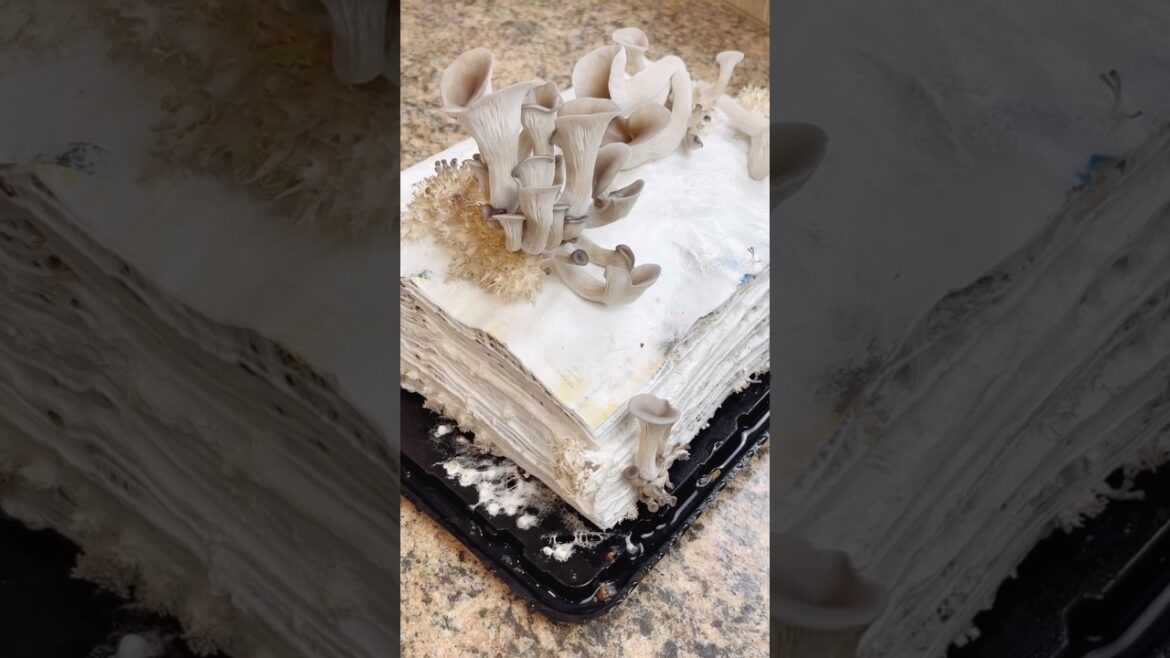#mushroom #fungi #oystermushroom
The oyster mushrooms in this video were not eaten as we don’t know the chemicals used to print this old phone book (old inks contain heavy metals).
This video demonstrates how oyster mushrooms grow on various substrates. This old phone book is made from recycled paper and sawdust.
Oyster mushrooms are saprophytic, meaning they feed on decaying organic matter like wood and other plant debris, made of cellulose, hemicellulose, and lignin. The mycelium, or vegetative part of the mushroom, secretes enzymes and acids to decompose these substances, releasing nutrients it can absorb. A few parasitic oyster mushrooms eat bacteria and nematodes. Oyster mushrooms are used in mycoremediation and are known to remove contaminants in soil, water, and wastewater.
The phone book was pasteurized in boiling water, providing an area for the mycelium to grow and establish, producing fruiting bodies or mushrooms. Once the book cooled, we added the mushroom spawn (grains inoculated with mushroom mycelium) between layers of pages at a 25% ratio. After inoculation, we placed the book in an undisturbed area with temperatures between 70–75 F to allow colonization. The incubation period can range from 2 to 4 weeks, depending on the environment. I cut out two 3-inch holes from the lid to allow air circulation and covered them with micropore tape.
Blue Oyster mushrooms benefit from cold shock to stimulate fruiting. We placed the container in the refrigerator for a day. Afterward, I put it in a well-lit area from direct sunlight. The book was misted with water 4X daily. The whole process took approximately 4-½ weeks.
Ensure your working area and tools are clean and sanitized to prevent contamination. We sprayed and wiped the counter, container, lid, and tongs with 70% isopropyl alcohol and wore disposable gloves. Please do your research.
Thanks for watching, and I hope you enjoyed it!
Below are affiliate links. If you make a purchase, I make a commission! Your support will assist me with future projects and videos. Thank you very much! Misilla
Mushroom Kits and Cultivation supplies: https://amzn.to/48LEO8X
10% Off Mushroom Cultivation Supplies at Olympus Myco, code, LTG10: https://www.olympusmyco.com/?sca_ref=5448326.uoc2cL8G4Y
My book “Four-Season Food Gardening” is available on Amazon and most online retailers!
Order here: https://amzn.to/3LjUC5Q
Learn To Grow’s Amazon Storefront:
https://www.amazon.com/shop/learntogrow1
Stay connected with Learn To Grow:
Learn To Grow: https://youtube.com/c/LearnToGrow1
Learn To Grow Mushrooms: https://www.youtube.com/@learntogrowmushrooms
Instagram page: https://instagram.com/learntogrow
Facebook: https://www.facebook.com/learntogrowmisilla
Tiktok: https://www.tiktok.com/@learntogrow1
Threads: https://www.threads.net/@learntogrow
X: https://x.com/learntogrow07
#growfood
#pleurotusostreatus #recycle #pleurotus #mushrooms #sustainability #reuse #reducereuserecycle


20 Comments
Next psilocybin 😎 🍄
Sorry i like my mushroom grown without ink 🤗
I probably wouldn’t eat them even though they’re probably better than supermarket food, but it would be great for composting or expanding your mycelium
The ink doesn't affect them? I feel like all the chemicals in a phone book isn't what you want in your mushrooms.
I’m more impressed you found a phone book in 2024! What an antique!
The mushroom has colonized the book
Now use Prince Harry's book XD
So random story….
I bid on a full storage unit at a place in Florida. I got outbid luckily bcuz when the guy went thru it , it was filled with old phone books and giant catalogs. You could've grown plenty of mushrooms with them!!!!😂😂😂
I wouldn’t eat these due to the chemicals in the book have probably been absorbed in the shrooms
ink…..?
Omg before I see like 500 more comments complaining about the ink …
READ. THE DESCRIPTION. PEOPLE.
THEY WROTE IT FOR A REASON. JFC.
…Cool demo btw! Mushrooms can really grow on anything 👍
Its a gorgeous art piece OMG if only you preserve it forever its stunningly beautiful
these cake vids are getting outta hand
ah the forbidden cake of death.. my favorite!!!
Let your mycelium do the walking
😅😂😊😁🍄👍👍🥰
The only thing my medical degree books are useful for😂
The print in phone book is highly toxic! Bravo for poisoning yourself…
The oyster mushrooms in this video were not eaten as we don’t know the chemicals used to print this old phone book (old inks contain heavy metals).
What was it that you placed between the pages? This is fascinating to me. I would love to learn how to grow them and others. Great video 😊